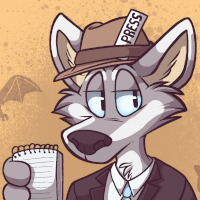Dubiously Canon, by Rukis – Book Review by Fred Patten
by Pup Matthias
Submitted by Fred Patten, Furry’s favorite historian and reviewer.
 Dubiously Canon, by Rukis
Dubiously Canon, by Rukis
Dallas, TX, FurPlanet Productions, June 2017, trade paperback, $19.95 (199 pages), e-book $9.95.
This is a mature content book. Please ensure that you are of legal age to purchase this material in your state or region. (publisher’s advisory)
“Synopsis: Tales from Red Lantern (that may or may not have happened)
A collection of stories chronicling the lives of characters in the Red Lantern universe, and their sexy misadventures.”
This collection contains five stories that originally appeared online. Four were written by reader demand to introduce two popular characters from throughout Rukis’ Red Lantern cartoon-art universe to each other, whether or not such a meeting would be possible by the story logic of this universe. So the stories are “dubiously canon”.
The four are “Language Barrier”, “Sinful Behavior”, “By Touch”, and “Ship to Ship”. All are narrated in the first person by one of the characters, most of whom are strangers to each other. Almost no names are mentioned. For readers familiar with Rukis’ Red Lantern art pages and her other novels, the descriptions of the characters will make it obvious who they are. In “Sinful Behavior”, for example, the wolfhound is Johannes Cuthbert from Red Lantern and Heretic and the bobcat is Shivah from the Off the Beaten Path trilogy. (That’s Shivah on the ship’s cannon on Rukis’ cover.) If you’re not familiar with Rukis’ Red Lantern universe – Mataa’s rocky coast in Legacy, the colony of Serwich in The Long Road Home, and so on – the locales and the characters won’t matter. All that really matters is that two healthy individuals come together, and erotic nature takes its course. M/m and m/f. Each of the four stories has a full-page NSFW illustration.


 Felicia: The Night of the Basquot, by Chas. P. A. Melville. Illustrated by the author.
Felicia: The Night of the Basquot, by Chas. P. A. Melville. Illustrated by the author. Melville later brought Felicia back in a series of text novelette booklets, with illustrations every few pages, published by CaféPress. These continued the lighter stories in ZU. Felicia became a professional sorceress-for-hire/detective who got involved with finding and dispelling ancient evils, or preventing their escape to wreak havoc in Katara and its neighboring animal kingdoms of Dogonia, Bruinsland (bears), Scentas (skunks), Rodentia (mice), and others. Melville wrote five of these, from Felicia and the Dreaded Book of Un (February 2004) to Felicia and the Border Collie Patrol (January 2008). One, Felicia and the Tailcutter’s Curse (June 2004), won that year’s Ursa Major Award in the Best Short Fiction category. All five were republished as a single book,
Melville later brought Felicia back in a series of text novelette booklets, with illustrations every few pages, published by CaféPress. These continued the lighter stories in ZU. Felicia became a professional sorceress-for-hire/detective who got involved with finding and dispelling ancient evils, or preventing their escape to wreak havoc in Katara and its neighboring animal kingdoms of Dogonia, Bruinsland (bears), Scentas (skunks), Rodentia (mice), and others. Melville wrote five of these, from Felicia and the Dreaded Book of Un (February 2004) to Felicia and the Border Collie Patrol (January 2008). One, Felicia and the Tailcutter’s Curse (June 2004), won that year’s Ursa Major Award in the Best Short Fiction category. All five were republished as a single book,  Griffin Ranger. Volume 1, Crossline Plains
Griffin Ranger. Volume 1, Crossline Plains The Fox of Richmond Park, by Kate Dreyer
The Fox of Richmond Park, by Kate Dreyer


 Sabrina Online: The Tail of Two Decades, by Eric W. Schwartz. Illustrated.
Sabrina Online: The Tail of Two Decades, by Eric W. Schwartz. Illustrated. Always Gray in Winter, by Mark J. Engels
Always Gray in Winter, by Mark J. Engels Legacy: Dusk, by Rukis. Illustrated by the author.
Legacy: Dusk, by Rukis. Illustrated by the author.